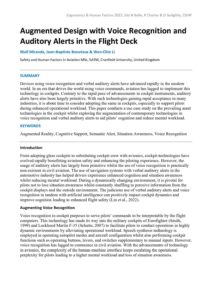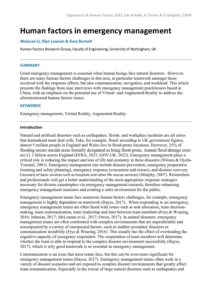Augmented reality
Evaluating System Usability of Augmented Reality in Flight Operations
| Document | Author Wen-Chin Li, Tim Bord, Jingyi Zhang, Graham Braithwaite and Mudassir Lone |
| Abstract The human-centred design of augmented visualisation aids can have significant effect on human performance and cognitive processes by increasing an operator’s capability to manage complex checklists. This study investigated the use of an Augmented Reality (AR) device as a cockpit integration tool and the possible new challenges relating to Human-Computer interactions it induces. Seventeen aviation professionals (pilots, engineers, and training pilots) aged from 23 to 53 (M=29.82, SD=8.93) participated in this experiment. Their flight experience ranged from zero flight hours to 3000 flight hours (M=605.00, SD=1051.04). Two types of interaction - by gesture and voice control, have been compared with traditional paper checklists. The results show that gesture control AR gives rise to unnecessary complexity and tends to be cumbersome to use. On the other hand, voice control AR checklists could constitute an improvement in terms of usability of checklists completion in flight operations. Paper checklists tend to score higher in terms of ‘learnability’ as it is the simplest way to use a traditional checklist. It is also interesting to find that voice control AR checklists tend to be rated as the highest on both the total score of System Usability Scale (SUS) and in terms of ‘usability’. These phenomena are consistent with the comments of participants that they would prefer to apply a voice control AR checklist over a paper checklist, if they were more familiar with it in the future. The improvement in modes of interaction and the presentation of information could lead to changes in usability and operational procedures. There is a need for further exploration of the implications of AR technology on the flight deck before implementation. |
Augmented Design with Voice Recognition and Auditory Alerts in the Flight Deck
| Document | Author Niall Miranda, Jean-Baptiste Bonotaux & Wen-Chin Li |
| Abstract Devices using voice recognition and verbal auditory alerts have advanced rapidly in the modern world. In an era that drives the world using voice commands, aviation has lagged to implement this technology in cockpits. Contrary to the rapid pace of advancements in cockpit instruments, auditory alerts have also been largely primitive. With such technologies gaining rapid acceptance in many industries, it is about time to consider adopting the same in cockpits, especially to support pilots during enhanced operational workload. This paper conducts a use case study on the prevailing aural technologies in the cockpit whilst exploring the augmentation of contemporary technologies in voice recognition and verbal auditory alerts to aid pilots’ cognition and reduce mental workload. |
Human factors in emergency management
| Document | Author Weixuan Li, Glyn Lawson & Gary Burnett |
| Abstract Good emergency management is essential when human beings face natural disasters. However, there are many human factors challenges in this area, in particular teamwork amongst those involved with the response efforts, but also communication, navigation, and workload. This article presents the findings from nine interviews with emergency management practitioners based in China, with an emphasis on the potential use of Virtual- and Augmented-Reality to address the aforementioned human factors issues. |



